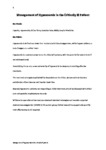Management of hypoxaemia in the critically ill patient
| dc.contributor.author | Flower, L | |
| dc.contributor.author | Martin, Daniel | |
| dc.date.accessioned | 2020-09-20T11:26:19Z | |
| dc.date.available | 2020-09-20T11:26:19Z | |
| dc.date.issued | 2020-01-02 | |
| dc.identifier.issn | 1750-8460 | |
| dc.identifier.issn | 1759-7390 | |
| dc.identifier.uri | http://hdl.handle.net/10026.1/16402 | |
| dc.description.abstract |
<jats:p> Hypoxaemia is a common presentation in critically ill patients, with the potential for severe harm if not addressed appropriately. This review provides a framework to guide the management of any hypoxaemic patient, regardless of the clinical setting. Key steps in managing such patients include ascertaining the severity of hypoxaemia, the underlying diagnosis and implementing the most appropriate treatment. Oxygen therapy can be delivered by variable or fixed rate devices, and non-invasive ventilation; if patients deteriorate they may require tracheal intubation and mechanical ventilation. Early critical care team involvement is a key part of this pathway. Specialist treatments for severe hypoxaemia can only be undertaken on an intensive care unit and this field is developing rapidly as trial results become available. It is important that each new scenario is approached in a structured manner with an open diagnostic mind and a clear escalation plan. </jats:p> | |
| dc.format.extent | 1-10 | |
| dc.format.medium | Print-Electronic | |
| dc.language | en | |
| dc.language.iso | eng | |
| dc.publisher | Mark Allen Group | |
| dc.subject | Acute respiratory distress syndrome | |
| dc.subject | Critical care | |
| dc.subject | Hospital medicine | |
| dc.subject | Hypoxaemia | |
| dc.subject | Hypoxia | |
| dc.subject | Intensive care | |
| dc.title | Management of hypoxaemia in the critically ill patient | |
| dc.type | journal-article | |
| dc.type | Journal Article | |
| dc.type | Review | |
| plymouth.author-url | https://www.webofscience.com/api/gateway?GWVersion=2&SrcApp=PARTNER_APP&SrcAuth=LinksAMR&KeyUT=WOS:000512298100003&DestLinkType=FullRecord&DestApp=ALL_WOS&UsrCustomerID=11bb513d99f797142bcfeffcc58ea008 | |
| plymouth.issue | 1 | |
| plymouth.volume | 81 | |
| plymouth.publication-status | Published | |
| plymouth.journal | British Journal of Hospital Medicine | |
| dc.identifier.doi | 10.12968/hmed.2019.0186 | |
| plymouth.organisational-group | /Plymouth | |
| plymouth.organisational-group | /Plymouth/Faculty of Health | |
| plymouth.organisational-group | /Plymouth/Faculty of Health/Peninsula Medical School | |
| plymouth.organisational-group | /Plymouth/REF 2021 Researchers by UoA | |
| plymouth.organisational-group | /Plymouth/REF 2021 Researchers by UoA/UoA01 Clinical Medicine | |
| plymouth.organisational-group | /Plymouth/Users by role | |
| plymouth.organisational-group | /Plymouth/Users by role/Academics | |
| dc.publisher.place | England | |
| dc.identifier.eissn | 1759-7390 | |
| dc.rights.embargoperiod | Not known | |
| rioxxterms.versionofrecord | 10.12968/hmed.2019.0186 | |
| rioxxterms.licenseref.uri | http://www.rioxx.net/licenses/all-rights-reserved | |
| rioxxterms.type | Journal Article/Review |


